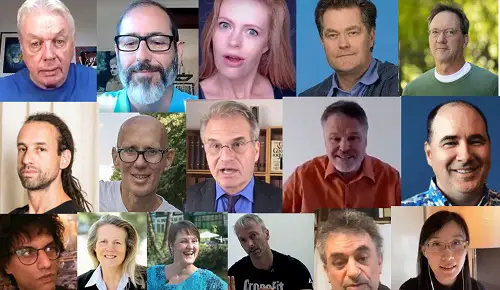|
TRANSLATE THIS ARTICLE
Integral World: Exploring Theories of Everything
An independent forum for a critical discussion of the integral philosophy of Ken Wilber
  Frank Visser, graduated as a psychologist of culture and religion, founded IntegralWorld in 1997. He worked as production manager for various publishing houses and as service manager for various internet companies and lives in Amsterdam. Books: Ken Wilber: Thought as Passion (SUNY, 2003), and The Corona Conspiracy: Combatting Disinformation about the Coronavirus (Kindle, 2020). Frank Visser, graduated as a psychologist of culture and religion, founded IntegralWorld in 1997. He worked as production manager for various publishing houses and as service manager for various internet companies and lives in Amsterdam. Books: Ken Wilber: Thought as Passion (SUNY, 2003), and The Corona Conspiracy: Combatting Disinformation about the Coronavirus (Kindle, 2020). TABLE OF CONTENTS | REVIEWS

Icke, Kaufman, Bailey, Borger, Cowan
Engel, Engelbrecht, Fuellmich, Lanka, McKernan Malhotra, Mikovits, Ossenbaard, Savalle, Scoglio, Yan The Silly Sixteen: |
| CHARACTER | PART(S) |
|---|---|
| ICKE, David - British former football player, conspiracy theorist since the '90, notorious for his reptilians-rule-the-world theory | 1, 11, 15, 18, 21, 27, 37 |
| KAUFMAN, Andrew - naturopath, virus denialist made famous by David Icke, spreads the notions that viruses are actually exosomes | 1, 2, 3, 4, 9, 12, 13, 16, 23, 25, 26, 31 |
| BAILEY, Samantha - virus denialist, medical YouTube influencer from New Zealand, co-author of Virus Mania | 23, 30, 35 |
| BORGER, Pieter - Dutch PCR skeptic, first author of the Corman-Drosten retraction request, creationist | 20, 24, 25, 29, 33 |
| COWAN, Tom - naturopath, virus- and contagion-denier, promotes the electromagnetic theory about COVID-19 (5G) and other pandemics | 19, 23, 25, 26, 34 |
| ENGEL, Willem - Dutch anti-lockdown activist, fights (and loses) dozens of legal battles against the Dutch government, dance teacher | 18, 25 |
| ENGELBRECHT, Torsten - German investigative journalist, main author of Virus Mania, the bible of virus denialism | 23, 30 |
| FUEHLLMICH, Reiner - German anti-lockdown lawyer, PCR skeptic, has since long announced class-action lawsuits against Drosten et al | 27, 32 |
| LANKA, Stefan - German biologist, virus denialist since '90, became famous when he lost (and won) the case about measles in court | 5, 7, 25, 26, 28, 32 |
| MALHOTRA, Bobby Majesh - Belligerent info warrior, PCR skeptic, co-author of the Corman-Drosten retraction request | 20, 24 |
| McKERNAN, Kevin - PCR skeptic, co-author of the Corman-Drosten retraction request, cannabis genome specialist | 20, 24 |
| MIKOVITS, Judy - discredited virologist, argued that fatigue syndrome has viral origin, main character of Plandemic | 14, 23 |
| OSSEBAARD, Janet - Dutch former crop circle specialist, QAnon influencer, became famous with her "Fall of the Cabal" series | 18, 19 |
| SAVALLE, Patrick - Dutch virus denialist (HIV/AIDS), PCR skeptic, investigative journalist, former blogger and IT-specialist | 20, 25 |
| SCOGLIO, Stefano - Italian naturopath, virus denialist, PCR skeptic, co-author of Virus Mania, alleged Nobel Prize nominee for medicine 2018 | 23, 25, 30 |
| YAN, Li-Meng - Hong Kong lab leak whistleblower, made famous by Fox News and Steve Bannon, author of several discredited papers | 17, 25, 36 |
| Researcher/ Theorist* | Mild virus of natural origin | Mild/deadly virus of lab origin | 5G/toxins/ stress, etc. |
|---|---|---|---|
| Icke | ✔ | ||
| Kaufman | ✔ | ||
| Bailey | ✔ | ||
| Borger | ✔ | ||
| Cowan | ✔ | ||
| Engel | ✔ | ||
| Engelbrecht | ✔ ? | ||
| Fuellmich | ✔ ? | ||
| Lanka | ✔ | ||
| Malhotra | ✔ ? | ||
| McKernan | ✔ | ||
| Mikovits | ✔ | ||
| Ossenbaard | ✔ | ||
| Savalle | ✔ | ||
| Scoglio | ✔ | ||
| Yan | ✔ | ||
| TOTAL | 5 | 2 | 9 |
* In order of appearance in The Corona Conspiracy series of articles.
THREE WAYS OF LOOKING AT THE PANDEMIC
Another way to look at the pandemic and its major players is to distinguish, as we have done in this series, between three different groups:
- MAINSTREAM SCIENCE
- LOCKDOWN & VACCINE SKEPTICS
- VIRUS DENIERS
Here are some representative authorities of these groups:

Dr. Sucharit Bhakdi, Dr. Michael Yeadon, Dr. John Ioannidis,
Dr. Stefan Lanka, Andrew Kaufman and Tom Cowan
There is, of course, an interesting dynamic between these three groups. Group 1 and Group 2 share a belief in viruses and science, even though they differ as to their harmfulness. Group 2 and Group 3 are both critical of mainstream science, but in different ways. Group 2 is somehow sandwiched in between Group 1 and Group 3 and is attacked from both sides. Group 3 sees Group 2 as... controlled opposition.
See also: Frank Visser / ChatGPT, "Examining Diverse Perspectives on the COVID-19 Pandemic", www.integralworld.net
| CONVENTIONAL POSITIONS |
|---|
|
1. Mainstream Public Health Perspective
Key Points: COVID-19 is a novel coronavirus that emerged naturally and caused a global pandemic. Governments and health organizations worked to mitigate its spread through measures like lockdowns, mask mandates, and vaccines. Vaccines, developed at unprecedented speed, are safe, effective, and critical to ending the pandemic. Supporters: World Health Organization (WHO), Centers for Disease Control and Prevention (CDC), mainstream media, and most governments. Critiques: Critics argue some measures (e.g., prolonged lockdowns) were overly restrictive and harmed economies and mental health. |
|
2. Skeptical but Science-Based View
Key Points: Acknowledges the seriousness of the pandemic but critiques specific policies or aspects of the response. Questions the efficacy of certain mandates (e.g., school closures) and stresses the need for cost-benefit analysis. Advocates for a more tailored, risk-based approach, particularly for vulnerable populations. Supporters: Some scientists, economists, and commentators (e.g., authors of the Great Barrington Declaration). Critiques: Critics see this view as downplaying risks and undermining collective public health efforts. |
|
3. Pro-Government Policy Advocates
Key Points: Defends strict measures, arguing they were necessary to save lives in an unprecedented crisis. Highlights the challenges of navigating incomplete data early in the pandemic. Argues for continued vigilance to prevent future pandemics. Supporters: Proponents of stricter health policies, certain political leaders, and public health officials. Critiques: Critics argue this perspective often overlooked the long-term consequences of restrictive measures. |
| CRITICAL AND DISSENTING PERSPECTIVES |
|
4. Libertarian and Anti-Lockdown Critics
Key Points: Oppose lockdowns, mask mandates, and vaccine requirements as infringements on personal freedom. Highlight economic damage, mental health crises, and the erosion of civil liberties. Argue for voluntary measures and personal responsibility rather than government mandates. Supporters: Libertarian politicians, certain conservative groups, and individual rights advocates. Critiques: Critics argue this approach neglects the need for collective action in public health emergencies. |
|
5. Vaccine Hesitancy
Key Points: Questions the safety and efficacy of COVID-19 vaccines, particularly given their rapid development. Expresses concern about potential side effects, lack of long-term data, and mandates. Advocates for individual choice and greater transparency. Supporters: Some segments of the public, alternative health communities, and certain political figures. Critiques: Critics argue this perspective amplifies misinformation and undermines public health efforts. |
|
6. Global Inequity Critics
Key Points: Focus on disparities in vaccine distribution and access to healthcare between wealthy and poorer nations. Criticize pharmaceutical companies and wealthy governments for prioritizing profits over global health equity. Advocate for waiving intellectual property rights to ensure broader vaccine access. Supporters: Global health activists, humanitarian organizations, and developing nations. Critiques: Critics argue that waiving patents alone wouldn't resolve systemic healthcare challenges in poorer countries. |
| FRINGE AND CONSPIRATIONAL VIEWS |
|
7. "Plandemic" Theories
Key Points: Claims the pandemic was orchestrated by global elites (e.g., the World Economic Forum, Bill Gates) to consolidate power and control. Suggests COVID-19 was a manufactured crisis to justify surveillance, vaccine mandates, or economic restructuring. Supporters: Fringe groups, conspiracy theorists, and some alt-right or anti-globalist communities. Critiques: Widely dismissed as lacking evidence and promoting paranoia. |
|
8. Lab Leak Conspiracy
Key Points: Posits that COVID-19 escaped from a lab in Wuhan, either accidentally or intentionally. Claims governments and the WHO covered up evidence of a lab origin to avoid accountability or geopolitical fallout. Supporters: Certain scientists, investigative journalists, and political commentators. Critiques: While a lab leak is debated as a possibility, the intentional release claim is largely considered conspiratorial. |
|
9. Anti-Vaccine Conspiracies
Key Points: Claims vaccines are a tool for population control, surveillance (e.g., through microchips), or profit for pharmaceutical companies. Argues vaccine-related deaths or severe side effects are being systematically covered up. Supporters: Fringe anti-vaccine movements, some alternative health influencers. Critiques: Critics emphasize the lack of credible evidence and the dangers of spreading misinformation. |
|
10. 5G and COVID-19 Theories
Key Points: Suggests a link between 5G technology and the spread or symptoms of COVID-19. Claims 5G weakens immune systems or interacts with the virus in harmful ways. Supporters: A niche group of conspiracy theorists. Critiques: Debunked by scientists and dismissed as pseudoscience. |
|
11. COVID-19 as a Bioweapon
Key Points: Suggests COVID-19 was intentionally engineered and released as a bioweapon, possibly by China, the U.S., or another state. Frames the pandemic as part of a covert geopolitical strategy. Supporters: Some geopolitical conspiracy theorists and nationalist factions. Critiques: No credible evidence supports this claim, and it is widely dismissed as speculative. |
83 Vaccine Myths from docbastard.net